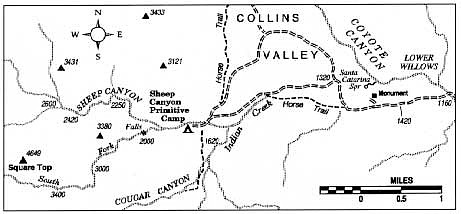 Facebook
Facebook
 X
X
 Instagram
Instagram
 TikTok
TikTok
 Youtube
Youtube
Hard-to-reach Sheep Canyon, secreted in the remote middle reaches of Coyote Canyon in Anza-Borrego Desert State Park, features some of the most rugged yet beautiful terrain in San Diego County. The canyon has two main forks (labeled Sheep Canyon and South Fork Sheep Canyon on maps), both containing trickling streams, full-skirted California fan palms, large sycamores, willowy cottonwoods, grottos with waterfalls, and boulder-sized rocks by the million.
Depending on recent rainfall, the canyon streams may or may not be flowing by late December, but there's almost always plenty of water in late winter and spring.
The starting point for hikes into either fork of Sheep Canyon -- Sheep Canyon Primitive Camp -- is accessible only by the toughest kind of four-wheel drive vehicle. Without this you face about three miles of final approach by horse, foot, or mountain bike.
Drive north from the north end of the paved DiGiorgio Road in Borrego Springs onto the unpaved, sometimes rough road up along the east side of Coyote Canyon. On the way in, you'll have an opportunity to pay the necessary Anza-Borrego use fee ($5 daily, $10 for three days) at a machine that will accept cash and credit cards.
After 5.6 miles on dirt and after three wet crossings of Coyote Creek, you reach a point below Lower Willows where the road turns sharply left (west) to climb a narrow, steep ravine. Parking space is fairly abundant just below the steep grade -- for those who wish to exit their vehicle and press on by other means.
The steep, rocky segment of the road ahead has claimed many an oil pan and broken many a shock absorber; nonetheless, brave four-wheelers blithely continue, negotiating an extremely difficult but short stretch. Thereafter, the road becomes smooth and the going is easy all the way to the Sheep Canyon campground.
After all this trouble it makes sense to stay at least one night at the campground, whether you've come by car or backpacked in. Your hiking excursions into the canyons can be as short or as long as you like.
Though parts of the main Sheep Canyon are rugged and overgrown with lush vegetation, foot traffic in the lower end has hewn out a followable, if primitive, footpath. From the campground it is only two miles -- and an elevation gain of 900 feet -- to a point where you enter a broad, bowl-shaped valley. This is a good place to enjoy the view of rugged peaks in every direction before turning around. Around the margins of the bowl, seasonal springs can be found in several of the small tributaries.
South Fork Sheep Canyon is, mile for mile, perhaps the most difficult canyon to explore in the whole county. The rewards for exploring it in depth are a close-up view of an idyllic 30-foot waterfall, glimpses of a half-dozen more cascades, and the pleasure of exploring a hidden, upper valley seldom visited by humans.


Hard-to-reach Sheep Canyon, secreted in the remote middle reaches of Coyote Canyon in Anza-Borrego Desert State Park, features some of the most rugged yet beautiful terrain in San Diego County. The canyon has two main forks (labeled Sheep Canyon and South Fork Sheep Canyon on maps), both containing trickling streams, full-skirted California fan palms, large sycamores, willowy cottonwoods, grottos with waterfalls, and boulder-sized rocks by the million.
Depending on recent rainfall, the canyon streams may or may not be flowing by late December, but there's almost always plenty of water in late winter and spring.
The starting point for hikes into either fork of Sheep Canyon -- Sheep Canyon Primitive Camp -- is accessible only by the toughest kind of four-wheel drive vehicle. Without this you face about three miles of final approach by horse, foot, or mountain bike.
Drive north from the north end of the paved DiGiorgio Road in Borrego Springs onto the unpaved, sometimes rough road up along the east side of Coyote Canyon. On the way in, you'll have an opportunity to pay the necessary Anza-Borrego use fee ($5 daily, $10 for three days) at a machine that will accept cash and credit cards.
After 5.6 miles on dirt and after three wet crossings of Coyote Creek, you reach a point below Lower Willows where the road turns sharply left (west) to climb a narrow, steep ravine. Parking space is fairly abundant just below the steep grade -- for those who wish to exit their vehicle and press on by other means.
The steep, rocky segment of the road ahead has claimed many an oil pan and broken many a shock absorber; nonetheless, brave four-wheelers blithely continue, negotiating an extremely difficult but short stretch. Thereafter, the road becomes smooth and the going is easy all the way to the Sheep Canyon campground.
After all this trouble it makes sense to stay at least one night at the campground, whether you've come by car or backpacked in. Your hiking excursions into the canyons can be as short or as long as you like.
Though parts of the main Sheep Canyon are rugged and overgrown with lush vegetation, foot traffic in the lower end has hewn out a followable, if primitive, footpath. From the campground it is only two miles -- and an elevation gain of 900 feet -- to a point where you enter a broad, bowl-shaped valley. This is a good place to enjoy the view of rugged peaks in every direction before turning around. Around the margins of the bowl, seasonal springs can be found in several of the small tributaries.
South Fork Sheep Canyon is, mile for mile, perhaps the most difficult canyon to explore in the whole county. The rewards for exploring it in depth are a close-up view of an idyllic 30-foot waterfall, glimpses of a half-dozen more cascades, and the pleasure of exploring a hidden, upper valley seldom visited by humans.
